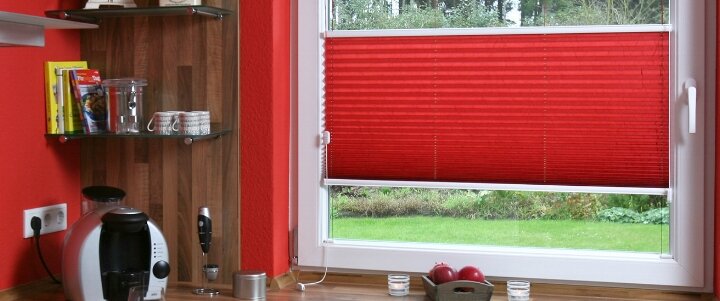Windows 103 - get dressed
Integrated cellular blind by Nordic Blinds on a double glazed uPVC tilt and turn window.
Snug-fitting window dressings reduce heat transfer by trapping a layer of still air next to the window. Ideally the fabric should be thick and insulative OR trap an extra layer of still air, like honeycomb blinds or two layers of curtains can do.
Pelmets, or a window dressing that effectively acts as a pelmet by closing off the space between the dressing and the top of window (eg. integrated cellular blinds) or the wall above the window (eg. roman blinds), are really the key to optimising the thermal performance of your windows.
NB. Pelmets don’t have to be obtrusive, fancy or expensive. A piece of cardboard cleverly concealed, or fabric draped across the top, does the job just as well. Team this up with bubble wrap stuck to the interior face of the window and you can make a single glazed window perform like a much fancier double glazed unit!
What insulative value (or R-value) do different types of window dressings add (according to the BERS Pro, a Nationwide House Energy Rating Scheme software):
Venetian (horizontal) and vertical blinds R 0.0
Holland blinds (basic roller blind) and very lightweight curtains R 0.03
Drapes (heavier curtains) R 0.06
Drapes + pelmet (or integrated cellular blinds) R 0.33
This means quality window dressings can nearly halve the rate of heat loss through a good double glazed window... and improve the performance of a single glazed window three-fold!
But remember, even a good double glazed window with a good window dressing transfers heat much faster than a section of R2 insulated wall alongside (approximately 3 times faster in fact) so think very carefully about the size of your windows. Just because it faces north doesn’t mean it makes sense to glaze the whole wall (particularly in the Canberra climate). Once the sun goes down you can quickly lose all of the heat your home absorbed when the sun was shining through the window earlier in the day. Every house is different in terms of location, orientation, views, thermal mass, insulation, airtightness... and, of course, people's priorities, budgets and preferences are equally varied. Finding the right balance for you and your particular home, and making informed "bang for buck" decisions, is the trick.
I ran the NatHERS modelling on a few of our projects to give you an idea how big an impact switching from window dressings such as holland blinds (R0.03) to good window dressings such as well-fitted cellular blinds (R0.33) can have on your heat loss over winter in Canberra.
Taking three of our new, well-oriented, double-glazed homes with good insulation to the ceilings, walls and floors (ranging from 7.4 to 8.4 stars EER), the reduction in predicted heating load ranged from 14 to 21%, or between 8 and 18 MJ/m²/year (~$150 a year at current ACT electricity prices).
For three older, single glazed houses with only ceiling insulation and less than ideal orientation (pre-retrofit/renovation ranging from 1.4 to 3.9 stars) the reduction in predicted heating load ranged from 8 to 17%, or 43 to 45 MJ/m²/yr (~$375 a year at current ACT electricity prices).
Of course this all assumes that your windows aren’t a big source of air leakage too (and I don’t just mean through the moving parts of the window, try sticking your finger nails, or worse still fingers, between the architrave and the wall at the top and bottom of your windows). More on that for another blog when you’ll all want to be armed with a caulking gun!
And remember when thinking about heat gain over summer, there is only so much a window dressing can do. Once the sun strikes the glass much of its heat is in your home, perhaps hidden behind the curtain initially but slowly but surely significantly raising the inside temperatures. To stay cool, the key is to shade the windows externally. See previous posts with tips on that here and here.
See Windows 101 for a refresher on R-values and U-values, and Windows 102 for an explanation of solar heat gain coefficients and glazing to floor area ratios.


